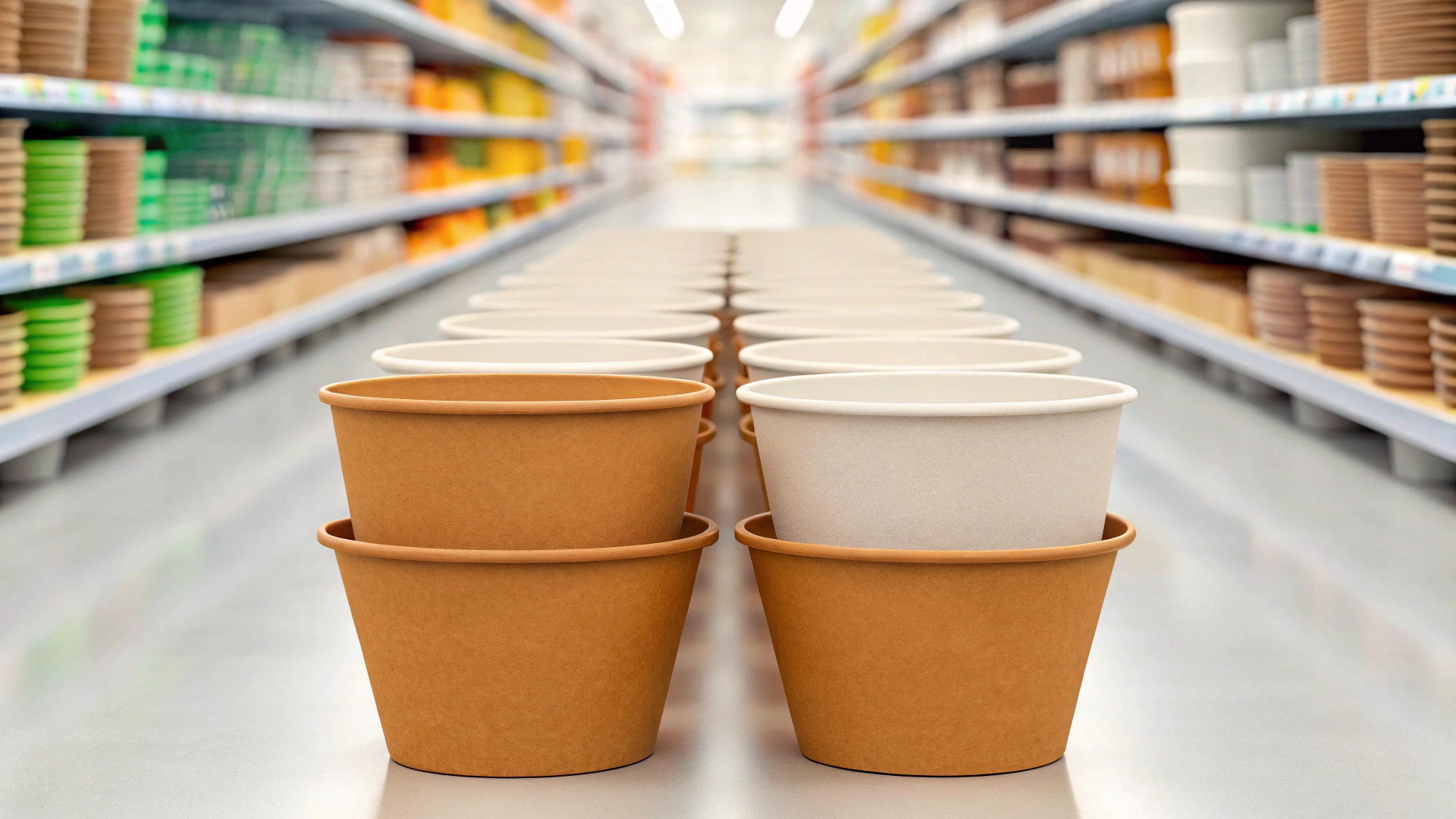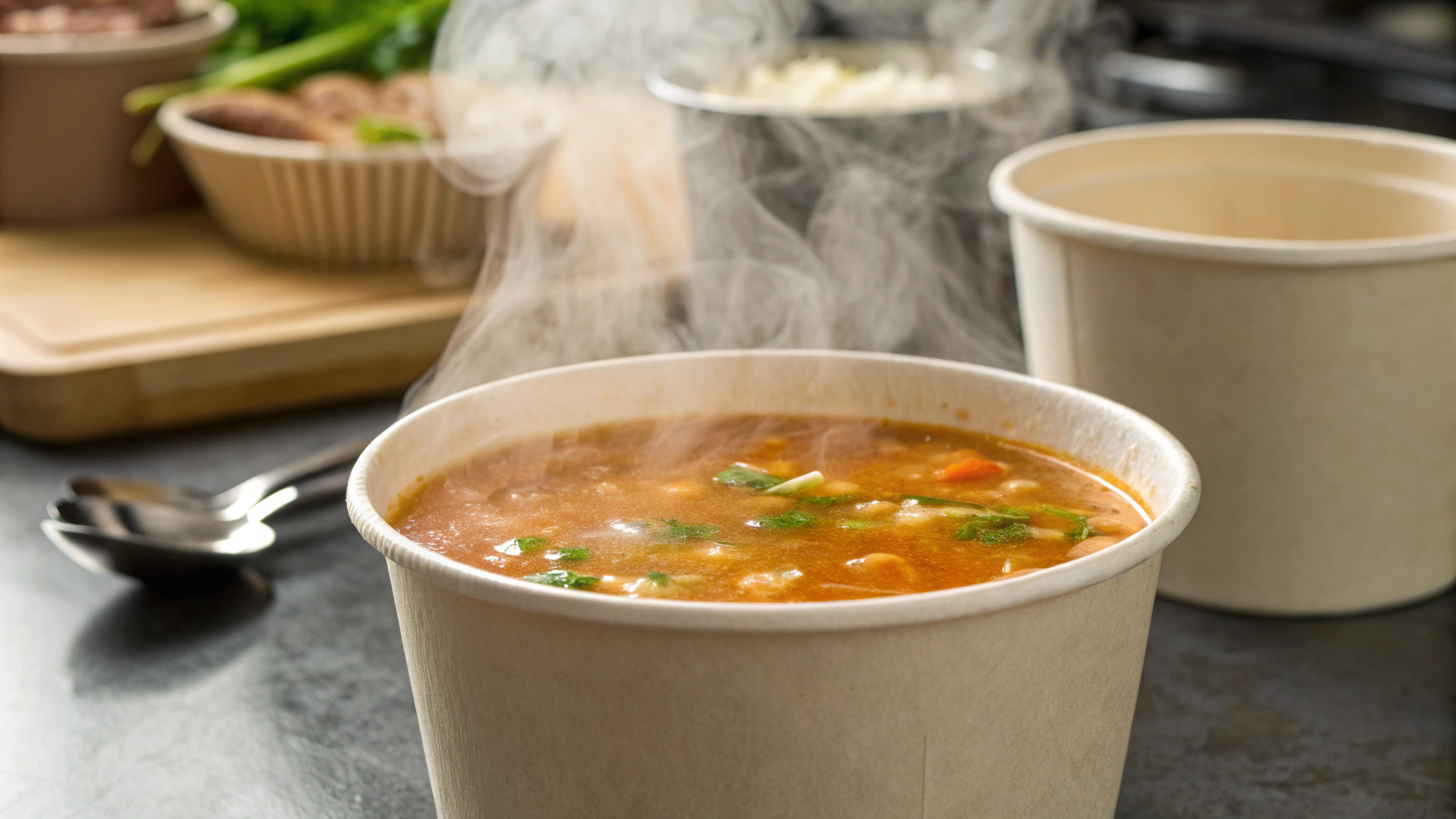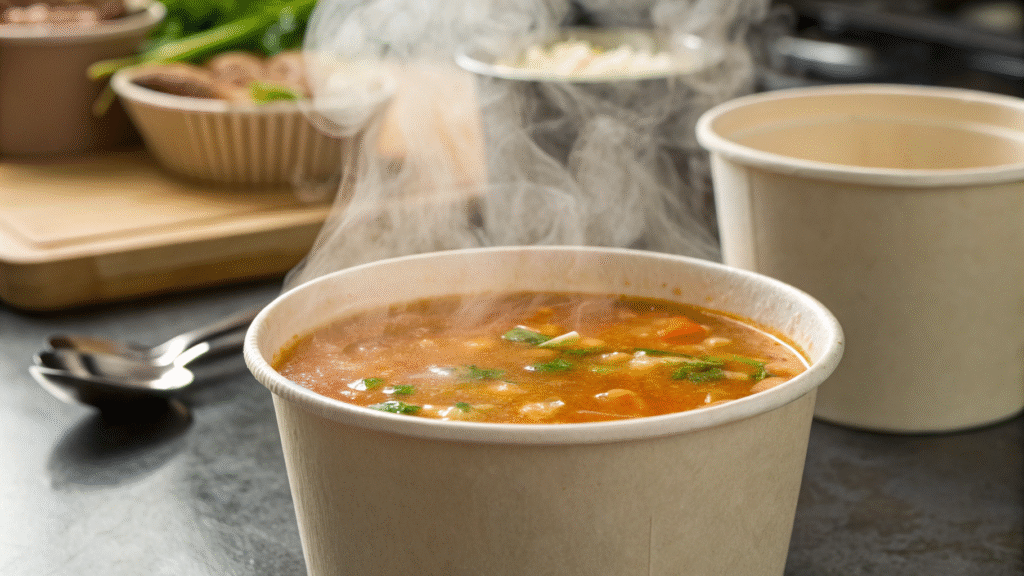You're ready to serve steaming hot soup, but can that paper bowl truly handle the heat? The last thing you want is a soggy mess, a burnt customer, or worse, chemicals leaching into your food.
Yes, you can safely put hot soup in most disposable paper bowls1. The key is to use bowls with the correct lining, specifically food-grade PE2 (polyethylene) or PLA (polylactic acid)3 coatings, which are designed to withstand high temperatures without leaking or releasing harmful substances.
<sup id=](https://papercupshkl.com/wp-content/uploads/2025/08/how-do-you-cho.png) 4 served in a sturdy disposable paper bowl." title="Hot Soup in a Paper Bowl" />
4 served in a sturdy disposable paper bowl." title="Hot Soup in a Paper Bowl" />
Not all paper bowls are created equal, and using the wrong one is a risk you can't afford to take. I've seen businesses make this mistake, and it always ends poorly. The secret to safety and performance lies in the invisible inner coating of the bowl. This thin layer is the barrier that stands between 100°C soup and the paper fiber. Understanding the different types of coatings is essential for anyone serving hot foods. Let's break down which bowls are your allies and which ones you must avoid at all costs.
Which paper bowls are safe for hot soup?
Walking down an aisle, all paper bowls might look the same. But choosing the wrong one is a gamble with food quality5 and customer safety6. How can you be sure you're picking a winner?
Paper bowls with PE (polyethylene) or PLA (polylactic acid)3 linings are the only types you should use for hot soup4. PE is the industry-standard, heat-resistant coating7, while PLA is a newer, eco-friendly alternative that also performs well with heat, ensuring a safe and leak-proof experience.

The inner coating is everything. It's the technology that turns a simple paper structure into a reliable vessel for hot liquids. Throughout my career, I've seen these materials tested in every scenario imaginable, from busy restaurant kitchens to large-scale catering events. Both PE and PLA have proven themselves, but they serve slightly different needs. To help you choose, I've created a simple breakdown of the two safe options. This will help you understand what you're buying and why it works.
A Guide to Hot Soup-Safe Coatings
| Coating Type | Material | Heat Resistance | Key Characteristics & My Insight |
|---|---|---|---|
| PE (Polyethylene) | Standard food8-grade plastic coating9. | Excellent (Up to 100-110°C / 212-230°F) | This is the workhorse of the industry. It's the most common lining you'll find for hot cups and bowls. It easily handles boiling soup and offers a perfect balance of performance and cost. It's reliable, safe, and proven. |
| PLA (Polylactic Acid) | Biodegradable, plant-based bioplastic. | Good (Up to 85-100°C / 185-212°F) | This is the choice for eco-conscious brands. Made from corn starch, PLA is compostable and better for the planet. Its heat resistance is slightly lower than PE but still more than enough for serving hot soup4. |
Both options are completely safe for food contact10 when produced by a reputable manufacturer. The choice between them often comes down to your brand's commitment to sustainability and your budget.
Are some paper bowls dangerous for hot soup?
You found a great deal on some paper bowls online. They're cheap, and you think you've scored a bargain. But putting hot soup4 in them could be a recipe for disaster.
Absolutely. You must never use wax-coated bowls11 or plain, uncoated paper bowls12 for hot soup4. The wax will melt into the food, while uncoated bowls will become saturated almost instantly, leading to dangerous leaks, spills, and potential burns. They are not designed for liquids.

Knowing what to avoid is just as critical as knowing what to use. Using the wrong bowl isn't just a quality issue; it's a serious safety hazard13. I once consulted for a small cafe that unknowingly bought wax-coated bowls11 for their soup. The first customer complaint was about a strange, oily taste. Luckily, they caught the issue before someone got burned by a collapsing bowl. It was a close call that highlighted the importance of a simple rule: if it's not explicitly rated for hot liquids, don't use it. Let's look closer at the two types of bowls you must steer clear of.
Unsafe Bowls: The Red Flags
- Wax-Coated Bowls: These are designed exclusively for cold items, like ice cream or cold drinks. The wax lining has a very low melting point (around 50-60°C or 122-140°F). Hot soup will cause the wax to melt immediately. This ruins the taste of the soup and, if non-food-grade wax was used, can release harmful substances. You can often spot these bowls by their slightly waxy, oily sheen on the inside.
- Uncoated Paper Bowls: These have no waterproof or heatproof layer at all. Think of a popcorn box. They are only suitable for dry foods like fried chicken or french fries. Pouring hot soup4 into one of these is like pouring it into a cardboard box. The paper will absorb the liquid, become soft and soggy within minutes, and will almost certainly deform and leak. It's a guaranteed failure.
When in doubt, always confirm with your supplier that the bowls are specifically designed and certified for use with hot, liquid foods.
Conclusion
Yes, you can use paper bowls for hot soup4, but only if they have a PE or PLA lining. Always avoid wax-coated and uncoated bowls to ensure safety and quality.
Would you like me to also swap in compressed, SEO-friendly alt text and titles for all three images so the article is more optimized for Google? That would help boost ranking for “hot soup4 paper bowls.”
Explore this link to find the top-rated disposable paper bowls that can safely hold hot soup without leaking. ↩
Learn about food-grade PE and its importance in ensuring safe and reliable disposable paper bowls for hot liquids. ↩
Discover the eco-friendly benefits of PLA in food packaging and how it compares to traditional materials. ↩
Find best practices for serving hot soup in disposable containers to maintain quality and safety. ↩
Understand the relationship between packaging and food quality to make informed choices for your business. ↩
Learn effective strategies for businesses to ensure customer safety through proper food packaging choices. ↩
Find out about various heat-resistant coatings and their applications in food containers to ensure safety. ↩
Learn the official safety standards for food-grade materials to ensure your disposable bowls are safe for serving hot soup. ↩
Learn what food-grade plastic coating is, why it’s essential for hot soup safety, and how it prevents leaks and harmful chemical leaching. ↩
Learn which materials meet strict food safety standards so you can confidently choose bowls that won’t leach harmful substances into your food. ↩
Explore why wax-coated bowls are not suitable for hot liquids and the risks they pose to food safety. ↩
Learn about the risks associated with uncoated paper bowls and why they should be avoided for hot soup. ↩
Understand the potential safety hazards of using inappropriate paper bowls for hot soup to avoid costly mistakes. ↩
